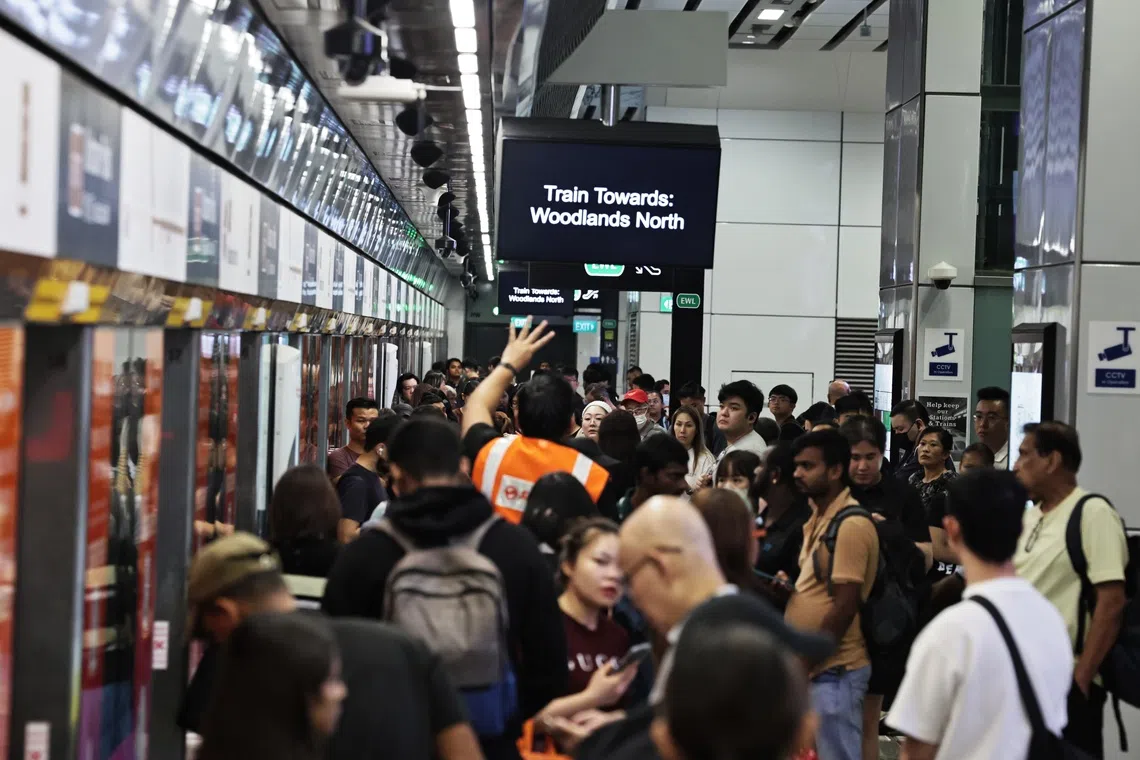Recent MRT disruptions isolated, not systemic in nature: SMRT Trains president
Sign up now: Get ST's newsletters delivered to your inbox

On the morning of Sept 17, a signaling fault at about 7.10am caused a two-hour disruption on the Thomson-East Coast Line.
ST PHOTO: KELVIN CHNG
Follow topic:
- SMRT addresses recent rail disruptions, stating they are isolated incidents, not systemic issues, and apologises for the inconvenience caused to passengers.
- SMRT will work with LTA, conducting assessments, technical audits, and improving incident response to minimise recovery time and prioritise passenger safety.
- Commuters had expressed frustration over underestimated delay times; SMRT acknowledges the need for improved communication during disruptions.
AI generated
SINGAPORE – The three rail disruptions that have occurred over the last four days on lines operated by SMRT are isolated cases and “not systemic issues across the rail network”, said Mr Lam Sheau Kai, president of SMRT Trains.
“We recognise the inconvenience these incidents cause, and sincerely apologise to affected commuters,” Mr Lam told reporters on Sept 17, hours after a signalling fault at about 7.10am caused a two-hour disruption
SMRT had initially warned of delays of up to 15 minutes, but later suspended services on the TEL for about 30 minutes to reset the signalling system, leaving some passengers stranded on board trains for an hour.
The signalling system directs rail traffic, keeps trains a safe distance from each other, and ensures they run according to schedule.
Mr Lam said SMRT is working with the Land Transport Authority (LTA) and the signalling system’s manufacturer to investigate the Sept 17 fault. The TEL’s signalling system is supplied by French company Alstom.
There have been at least five disruptions across the MRT network in September alone, including the latest on Sept 17, as well as those on the East-West Line (EWL) on Sept 16 and North-South Line (NSL) on Sept 14.
The latest trip-ups follow a string of rail disruptions in July and August, including on the Bukit Panjang LRT line, as well as the SBS Transit-run North East Line, Sengkang-Punggol LRT system
Before this spate of incidents, the MRT network’s overall reliability had already fallen to its lowest level since 2020
At a press briefing at Kim Chuan Depot on Sept 17, Mr Lam said SMRT will work closely with LTA on three areas moving forward, with the first being a detailed assessment of SMRT’s rail assets.
In addition to the TEL, SMRT runs the NSL, EWL and Circle Line (CCL). It also operates the Bukit Panjang LRT.
Mr Lam pledged to strengthen the management of SMRT’s rail system, and speed up asset renewal and upgrading where needed. This is part of the operator’s commitment to reliability, he said.
Second, SMRT and LTA will carry out technical audits of the operator’s critical systems. This is to “identify gaps, areas for improvement and response procedure”, he said. These include audits on the power, signalling, train and track systems.
Finally, when handling incidents, SMRT will do its best to shorten the recovery time, while applying a safety-first approach for passengers and staff, Mr Lam said.
“Safety precautionary measures, which typically take two to three hours, are necessary to ensure the protection of all,” he added.
Addressing complaints by passengers caught in disruptions who felt that SMRT had downplayed the length of delays, Mr Lam acknowledged that there is room for improvement.
“For each incident, the impact on each commuter varies depending on where one is within the train network,” he said.
“This is an area that we are looking to work on with LTA.”
Passengers affected by the TEL disruption on the morning of Sept 17 had told The Straits Times that there was frustration at initial announcements about a delay of 15 minutes, when the trains they were on had stopped moving for a much longer time.
“Everyone was upset,” said one commuter, a 32-year-old human resources executive who wanted to be known only as Ms Kok.

A signalling fault at about 7.10am on Sept 17 caused a disruption across the entire Thomson-East Coast Line.
ST PHOTO: LIM YAOHUI
Mr Alvin Lee, a manager in healthcare operations who managed to take an alternative route to Woodlands, said: “While disruption is unavoidable, the frequency of updates by SMRT on train disruptions can be improved.”
The Sept 17 disruption resulted in 18 students being late for their N-level examination
Mr Lam pointed out that SMRT is testing new crowd management measures and way-finding signs
These measures, which include the deployment of more staff on the ground and providing them with high-visibility vests and portable speakers, will be rolled out progressively to other major MRT interchanges, the rail operator had told ST.
Details of other MRT disruptions in September
Sept 16
Late on Sept 16, train services were halted on a six-station stretch of the EWL
The disruption, which happened at about 11pm, was caused by a faulty component in the power system, Mr Lam said. This in turn caused a signalling failure.
Mr Lam said the faulty part has been isolated, and normal train service resumed on the morning of Sept 17.
Sept 14
At about 11.45am on Sept 14, a faulty train on the NSL caused delays of up to 25 minutes
Passengers had to disembark before another train could move the faulty one away, thereby allowing service to resume, said Mr Lam.
Sept 2
On Sept 2, a faulty train caused a 45-minute disruption
At about 8.20pm, SMRT warned commuters to factor in an additional 25 minutes of travel time between Woodlands and Yishun stations.
Sept 1
A faulty train disrupted service on the CCL
The disruption affected a three-station stretch between Marina Bay and Promenade.
Additional reporting by Sherlyn Sim, Koh Ming Lun and Daniel Lai

